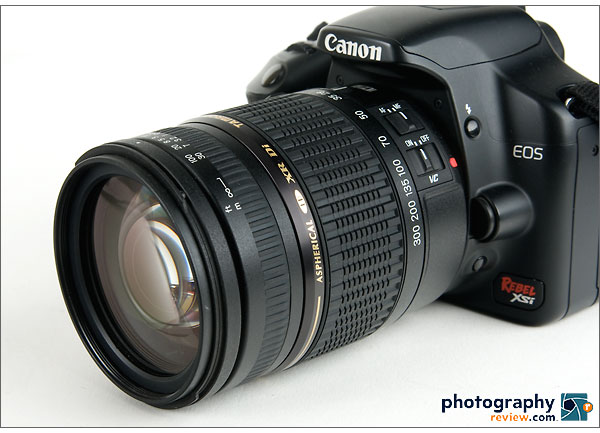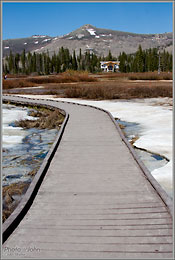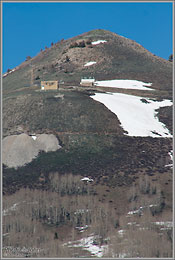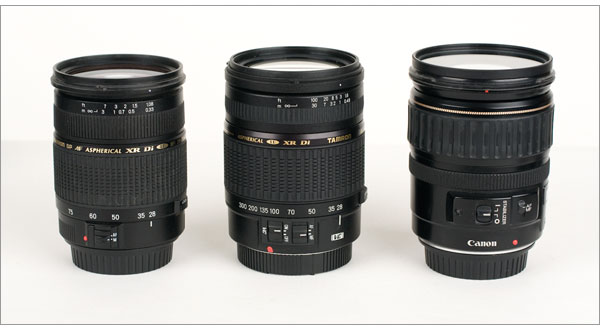The Tamron AF28-300mm F/3.5-6.3 XR Di VC Lens:
Tamron’s First Image Stabilized Lens
Street Price: Approximately $600 US
Tamron’s AF28-300mm F/3.5-6.3 XR Di VC LD Aspherical (IF) Macro lens is a do-it-all superzoom lens with Tamron’s new, proprietary “Vibration Compensation” optical image stabilization system. It’s their first lens to include image stabilization. The Tamron 28-300mm F/3.5-6.3 XR Di VC lens is compatible with 35mm and digital SLRs and is currently available with Canon and Nikon lens mounts.

Introduction
We all want a lens that can do it all. And the 28-300mm range is definitely something to covet – even if 28mm isn’t really wide for those of using APS-C digital SLRs. (See article and announcement for Tamron’s planned AF18-270mm F/3.5-6.3 Di II VC MACRO Lens) Regardless, the Tamron 28-300mm XR Di VC lens offers a ton of reach in a very compact package. I was most interested in finding out how Tamron’s new Vibration Compensation (VC) optical image stabilization worked. But I was also curious about whether a $600 28-300mm zoom lens would make me happy. I’m always looking for ways to cut down the weight and bulk of my backpack when I’m skiing, mountain biking, or hiking.
|
|
| Zoom Range / Angle-Of-View: | ||
 28mm |
 100mm |
 300mm |
| (click on photos for larger versions) |
||
Tamron AF28-300mm F/3.5-6.3 XR Di VC Build & Design
There are a bunch of letters at the end of the lens name that need some explanation. They’re there for a reason and they actually mean something. Tamron’s AF28-300mm F/3.5-6.3 XR Di VC LD Aspherical (IF) Macro lens uses most of their best technology. “VC” stands for “Vibration Compensation,” “XR” indicates that the lens uses “Extra Refractive Index Glass”, “LD” stands for “Low Dispersion,” and “Di” means this is one of Tamron’s ” Digitally Integrated” lenses, designed for optimal performance with either DSLRs or 35mm film cameras. And although it’s not a true macro (it doesn’t have 1:1 focusing), the 28-300 VC lens can focus as close as 19.3 inches (0.49m) across the whole zoom range
I tested the Tamron 28-300mm F/3.5-6.3 XR Di VC lens on a Canon EOS Rebel XSi (450D) and a Canon EOS 40D. The first thing I noticed was how light and compact it is for a 28-300mm lens – especially one that includes an optical image stabilization system. That’s not to say it’s actually small, light, or feels flimsy. In size and weight it’s a bit bigger than the Tamron AF28-75mm f/2.8 XR Di lens and a little smaller than the Canon EF 28-135mm f/3.5-5.6 IS lens. But it’s small compared to my Canon 300mm f/4L and miniature compared to Canon’s monster 28-300 f/3.5-5.6L IS pro lens. Mechanically, it’s very nice, with a solid feel and smooth zoom action. It has a locking switch to keep it from zooming out when it’s pointed down and internal focusing means the front element doesn’t spin, making it friendly to circular polarizers.
 |
|
| Tamron 28-300mm F/3.5-6.3 XR Di VC lens size comparison. Left to right: Tamron 28-75mm f/2.8 XR Di, Tamron 28-300mm F/3.5-6.3 XR Di VC, Canon EF 28-135mm f/3.5-5.6 IS |
|
next page – Tamron 28-300mm XR Di VC Lens Image Stabilization & Image Quality >>
next page – Tamron 28-300mm XR Di VC Lens Image Stabilization & Image Quality >>


Pingback: Tamron 15x AF18-270mm F/3.5-6.3 Di II VC MACRO Lens
Pingback: Tamron AF28-300mm Di VC European Consumer Lens of The Year
Pingback: Tamron SP AF10-24mm F/3.5-4.5 Di II LD - 2.4x Ultra Wide-Angle Zoom Lens
Well, I actually need suggestion on this lens for I am considering to have this one, plugged into my nikon d90.
A well written review, thank you.
I have just ordered this along with my D700 – Lets see how they perform together.
Best regards,
Michael Nielsen
i am planning to buy this lens but confused if they have a different one for Canon mount than the Nikon mount. does it make a difference? do i have to mention it specifically on my order? i have a canon rebel XS… your comments will be appreciated.
Yes, each camera maker uses their own lens mount and you do need to specify when you order or the lens won’t fit. If you order online the order process should have you choose your lens mount. If it doesn’t, I think I’d look for a different dealer because that’s not an indication that they understand cameras.
Before you buy any camera online, make sure to check our Camera Dealer Feedback forum. There are tons of sleazy online camera dealers out there trying to make a quick buck. It’s best to shop by dealer reputation and not by price. If the price is too good to be true, it most likely is a scam.
If you really care about very sharp photos, don’t buy this one. I have tried every setting available and even with the VC off, the mirror up on my Canon40D and using a tripod, the pictures are very soft.
What happens when you plug in an extender?
Randy-
You can use a tele-extender with this lens. Depending on the extender and the what you’re zoomed to, you’ll be looking at maximum apertures as slow as f/11. You’ll also likely see some compromised image quality. Since this lens is already a bit of a compromise, using a tele-extender might yield pretty poor results. I wouldn’t want to use more than a 1.4x extension and even then you might end up disappointed. The only way to know for sure is to try it, though.
Does this come on a Pentax mount?
hi i’m new in photography, i would like to buy this lens (reasons : easy to use lens, all-in-one)
i study in college, advertising program
so my photography skill will be used for advertising,
is it the right lens for me ? if not, why ? you have any suggestion for another all-in-one (wide to telephoto) lens ?
kiki-
I think this would be a fine lens for you. However, I prefer the 18-200mm zoom lenses because I think they have better optics. If you think you really need the 300mm telephoto end then this is a good, inexpensive option. But if image quality is a priority for you, then get something shorter.
Photo-John -
ohh, i’ve read many review about lenses, and i just found a better lens, Tamron 18-270mm, many people says it have better image quality than this lens, but i also find a multipurpose lens at SIGMA lens, and i found the 18-250 lens, it have better feature, and also cheaper, but it also heavier and bigger
i confused to choose one of both, but i think i’d prefer the tamton lens to sigma lens, cause they have better reputation, IMO
Has anyone tried it on the Canon 5D Mark II, if so what is the report ?
Does it work or not?
WHat if any problems you encountered?
Waiting for inro..